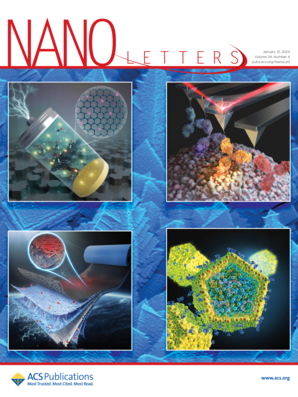Barcoding Microtubules: Encoding Information onto Macromolecules by Photobleaching
IF 9.6
1区 材料科学
Q1 CHEMISTRY, MULTIDISCIPLINARY
引用次数: 0
Abstract
Kinesin-1-powered microtubules have emerged as versatile components in biocomputing and biosensing technologies. However, the inability to identify and track individual microtubules has constrained their applications to ensemble behaviors, limiting their potential for single-entity-based nanotechnologies. To address this challenge, we present a novel method for encoding digital information directly onto individual microtubules using photobleaching patterns. Binary numbers (1 to 15) were encoded within ∼12 μm segments of moving microtubules by photobleaching with a stationary pulsed laser, creating spatial frequency patterns corresponding to distinct bits of information. Fourier analysis enabled the accurate retrieval of the encoded data, demonstrating the feasibility of direct information storage and retrieval on macromolecular structures. This approach offers a transformative solution for recording microtubule trajectories within nanotechnological devices by encoding path information directly onto microtubules at branch points, obviating the need for video-based tracking. We anticipate that this innovation will advance the development of individualized microtubule-based technologies.

微管条形码:通过光漂白将信息编码到大分子上
本文章由计算机程序翻译,如有差异,请以英文原文为准。
求助全文
约1分钟内获得全文
求助全文
来源期刊

Nano Letters
工程技术-材料科学:综合
CiteScore
16.80
自引率
2.80%
发文量
1182
审稿时长
1.4 months
期刊介绍:
Nano Letters serves as a dynamic platform for promptly disseminating original results in fundamental, applied, and emerging research across all facets of nanoscience and nanotechnology. A pivotal criterion for inclusion within Nano Letters is the convergence of at least two different areas or disciplines, ensuring a rich interdisciplinary scope. The journal is dedicated to fostering exploration in diverse areas, including:
- Experimental and theoretical findings on physical, chemical, and biological phenomena at the nanoscale
- Synthesis, characterization, and processing of organic, inorganic, polymer, and hybrid nanomaterials through physical, chemical, and biological methodologies
- Modeling and simulation of synthetic, assembly, and interaction processes
- Realization of integrated nanostructures and nano-engineered devices exhibiting advanced performance
- Applications of nanoscale materials in living and environmental systems
Nano Letters is committed to advancing and showcasing groundbreaking research that intersects various domains, fostering innovation and collaboration in the ever-evolving field of nanoscience and nanotechnology.
 求助内容:
求助内容: 应助结果提醒方式:
应助结果提醒方式:


